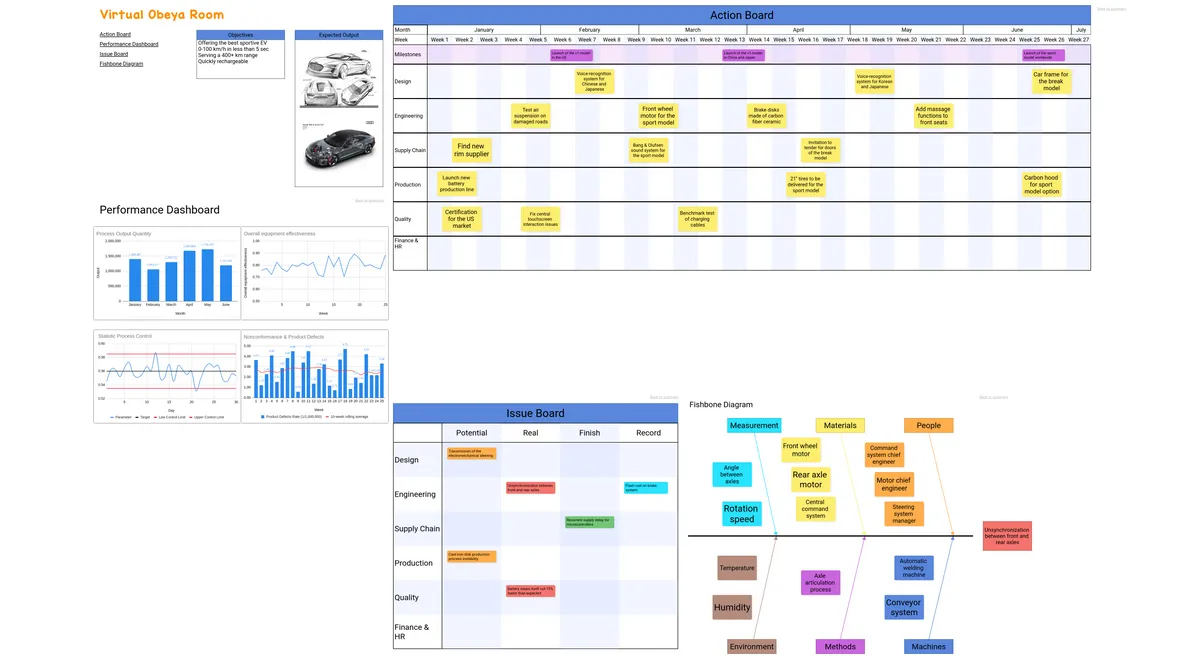What is Obeya?
The word Obeya means “big room” in Japanese. It describes a central place where leaders and operational teams within organizations can leverage visual management tactics together to brainstorm, ask important questions, challenge each other’s ideas, and break down siloes—all in an effort to deliver maximum value to customers while also minimizing waste.
The Obeya Room was first used by Toyota in 1993 when launching the new Prius model. To address high market expectations and meet tight deadlines, the company’s engineers immediately saw the importance of having all product- and performance-related information easily accessible in a single area for all cross-functional teams to work with. For them, this was the key to fueling better decision-making during the development of the new car model.
Although this specific use case of the Obeya method applies to big industrial production, it can be used in virtually any sector or situation—especially in the realm of software and digital product development. As stated by Tim Wiegel in Leading with Obeya, “[The Obeya method] has the potential to align strategy, sharpen focus, share meaningful context, and bring about learning and improvement skills for both leadership and operational teams.”
How to create an Obeya Room
Tim Wiegel suggests organizing an Obeya Room into five key areas:
1. Lead Successful Strategies
This is the starting point of your Obeya Room. Here, the goal is to hone in on the project's purpose (the “why”), the high-level strategy driving it forward, and the strategic capabilities of the team that will bring it to life (i.e., the skills, resources, and teams required to achieve the project’s core objectives). Consider this a “North Star” that influences decision-making while also helping the entire team stay focused on what matters the most for both an organization and its customers.
Depending on your project, you may want to identify key customer or stakeholder needs and also share learnings and analyses gleaned from the PESTEL Analysis Framework.
2. Deliver Value
“The delivery of value is about how we spend the time and resources available to us, to maximize value for customers and our organization,” explains Wiegel. This area typically includes four key parts:
- Value Stream Map: Breaks down a process into a series of steps.
- Portfolio Funnel: Assembles and prioritizes ideas before going into production.
- 12- to 18-Month Roadmap: Forces teams to stay focused on the project’s goals while also helping them anticipate what’s on the horizon (near- and long-term).
- Kanban Board: Helps teams manage day-to-day tasks.
3. Drive Performance
Here is where all key metrics enabling the team to measure success are displayed. These are typically linked to the strategic capabilities in the Lead Successful Strategies area.
For Wiegel, there are two kinds of metrics:
- Outcome Metrics: Measure the performance of each strategic capability.
- Supporting Metrics: Measure the things that can impact the outcome (either directly or indirectly). For example, if an Outcome Metric is total production cost, then the associated Supporting Metrics could be the cost of raw materials, labor, etc.
4. Act & Respond
This is a dedicated space where teams can centralize requests and decisions that can improve the process. Each task is tracked and assigned to someone who will ultimately be accountable for implementing it. The objective here is to be able to remove roadblocks quickly by getting experts or key decision-makers involved when necessary.
5. Solve Problems
This area is used for identifying problems, assessing workload, defining expected outcomes, prioritizing problems to solve, and logging new learnings.
The Obeya method’s impact on project management
Obeya is not simply about visualizing the work and performance of a project team. More importantly, it’s about creating a new and more effective approach to project management. Part of this involves respecting a new rhythm of work (including meetings) in order to leave more time and mind space for actually getting the work done, preparing for meetings, and collecting all of the facts and data needed to drive informed decision-making.
Since working with Obeya allows for more transparency around how teams work—including accountability as well as the results they are expected to drive—it can feel like a major shift (compared to your typical way of working) and can sometimes be met with resistance in the beginning. This is why it is recommended to start by implementing this method little by little and then refine, improve, and elaborate upon the process as the team begins to adopt and get used to this new way of working.
